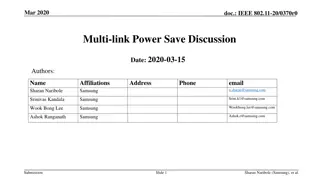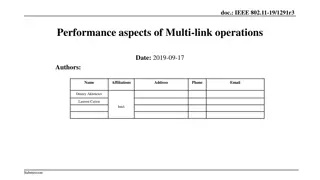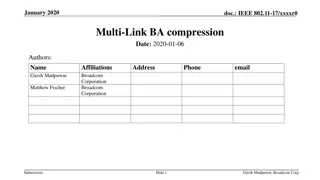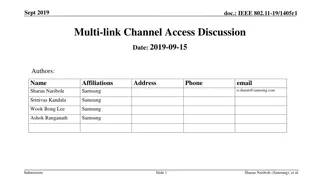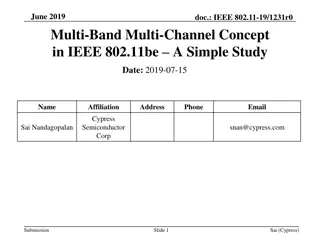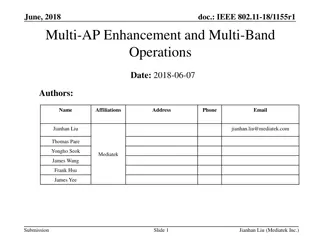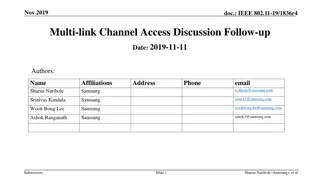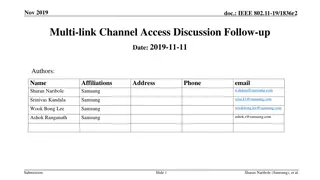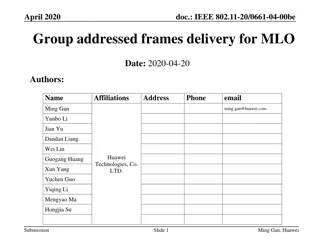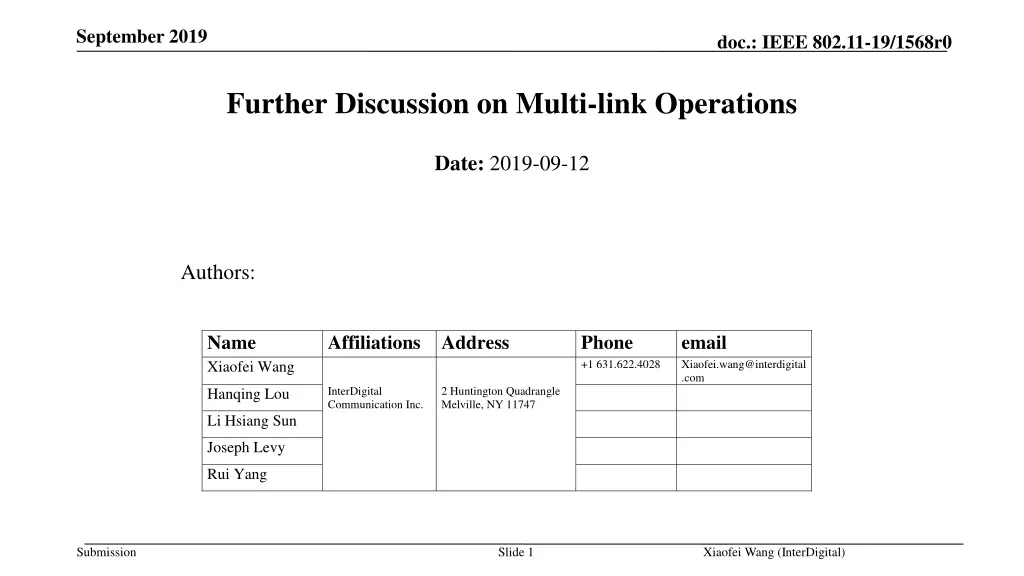
IEEE 802.11-19/1568r0 Multi-Link Operations Discussion
"Explore simplified data flows in multi-link operations for IEEE 802.11be with a focus on using a single ID/MAC address in data frames. Benefits include easier packet identification, unique sequence number generation, and streamlined multi-channel aggregation. Discover approaches for optimizing multi-link data transmissions in this detailed discussion."
Download Presentation

Please find below an Image/Link to download the presentation.
The content on the website is provided AS IS for your information and personal use only. It may not be sold, licensed, or shared on other websites without obtaining consent from the author. If you encounter any issues during the download, it is possible that the publisher has removed the file from their server.
You are allowed to download the files provided on this website for personal or commercial use, subject to the condition that they are used lawfully. All files are the property of their respective owners.
The content on the website is provided AS IS for your information and personal use only. It may not be sold, licensed, or shared on other websites without obtaining consent from the author.
E N D
Presentation Transcript
September 2019 doc.: IEEE 802.11-19/1568r0 Further Discussion on Multi-link Operations Date: 2019-09-12 Authors: Name Xiaofei Wang Affiliations Address InterDigital Communication Inc. Phone +1 631.622.4028 email Xiaofei.wang@interdigital .com 2 Huntington Quadrangle Melville, NY 11747 Hanqing Lou Li Hsiang Sun Joseph Levy Rui Yang Submission Slide 1 Xiaofei Wang (InterDigital)
September 2019 doc.: IEEE 802.11-19/1568r0 Abstract In this contribution, we follow up on the discussion on using a single ID/MAC address to identify MLE and MLD, and include such address in data frames in order to simplify data flows in multi-link operations. Submission Slide 2 Xiaofei Wang (InterDigital)
September 2019 doc.: IEEE 802.11-19/1568r0 Introduction Multi-link operations have been identified as a feature for 802.11be Architectures enabling multi-band/multi-link operations for 802.11be have been discussed, e.g., in [1] [2] Proposed the concept of Multi-link entity (MLE) and Multi-link Device (MLD) A common identifier for MAC-SAP or by DSM either on MLE level or MLD level We have had some initial discussions on design choices that may simplify data flow [4] Multi-link devices such as MLD or MLE should be identified by the ID or MAC address of their high MAC SAPs For multi-link data flows, it may be beneficial to include in the data frames a single ID or MAC address of the high MAC-SAP of the target MLD and MLE In this contribution, we discuss some approaches to include such single ID or MAC address of the high MAC-SAP of the target MLD and MLE Submission Slide 3 Xiaofei Wang (InterDigital)
September 2019 doc.: IEEE 802.11-19/1568r0 Recap of the previous multi-link discussion in [4] UL and DL data flows are between the high MAC-SAPs of the MLEs/MLDs that contain APs and non-AP STAs Hence, the high MAC-SAPs should be identified by IDs or MAC addresses Therefore, it is beneficial to have these IDs or MAC addresses included in the MAC frames E.g., in one of the address fields in data frames Submission Slide 4 Xiaofei Wang (InterDigital)
September 2019 doc.: IEEE 802.11-19/1568r0 Recap of benefits using a single ID for multi-link data transmissions A data frame can be clearly identified to be meant for higher layers if it contains the ID or MAC address of the target higher MAC SAP of the target MLD or MLE Sequence numbers can be generated uniquely from the same sequence number space and it is easy to re-assemble fragments, packets and detect duplication If dynamic link switching is desired, a packet can be transmitted over any link without having to regenerate MAC headers It is easier to identify packets when multi-channel/multi-band aggregation is used to transmit a wide-bandwidth frame Some of these benefits may depend on the particular design of multi-link operations defined in 802.11be Submission Slide 5 Xiaofei Wang (InterDigital)
September 2019 doc.: IEEE 802.11-19/1568r0 Possible approaches (1/4) During the previous discussions, there were some questions on the exact methods of including in data frames the high MAC SAP ID/MAC Address for target MLE and MLE Some possible approaches to indicate high MAC SAP ID in a data frame/PPDU may be: 1. In the preamble 2. In the MAC header 3. In the Frame body 4. Not include high SAP ID in data frames/PPDUs, instead making the mapping internal to an MLE/MLD 5. Other options Submission Slide 6 Xiaofei Wang (InterDigital)
September 2019 doc.: IEEE 802.11-19/1568r0 Possible approaches (2/4) Option 1: Including the high MAC SAP ID in the preamble PAID/Group ID are currently included in preambles Traditionally, the preamble is not a place to provide MAC level identifications for data flow; e.g., the PAID/Group ID in the preamble may be used for power saving purposes Can consider using multi-link AID if TGbe decides to define it May not be the best place to include high MAC SAP ID Option 2: Including the high MAC SAP ID in the MAC header MAC addresses currently may be included in one of the four Address fields in a data frame Other fields in the MAC header may be used as well Spec modification is required for receiving STAs to add more addressing filtering rules for high MAC SAP IDs in order to make the scheme plausible Data flow can benefit from multi-link operations as discussed above The exact benefits will depend on the particular design for multi-link operation Submission Slide 7 Xiaofei Wang (InterDigital)
September 2019 doc.: IEEE 802.11-19/1568r0 Possible approaches (3/4) Option 3: Including the high MAC SAP ID in the frame body of a data frame Can provide some benefits from multi-link operations as discussed above May not be able to be link-agnostic for link switching, link aggregation, etc., depending on the MAC header addressing schemes May ease duplication detection, fragmentation re-assemble and acknowledgement procedures for multi-link operations Requires additional rules to be defined by TGbe for receiving STAs to recognize high MAC SAP IDs Submission Slide 8 Xiaofei Wang (InterDigital)
September 2019 doc.: IEEE 802.11-19/1568r0 Possible approaches (4/4) Option 4: Not include the high MAC SAP ID in data frames/PPDUs, instead making the mapping to high MAC SAP ID internal within an MLE/MLD Was mentioned as an option during discussions No changes to the current over the air MAC protocols Requires additional queueing/duplication detection designs over multiple links May require new acknowledgement procedures for multi-link operations Requires additional rules between low MAC and high MAC SAP May not be able to be link-agnostic for link switching, link aggregation, etc., depending on the MAC header addressing schemes Option 5: Other options Submission Slide 9 Xiaofei Wang (InterDigital)
September 2019 doc.: IEEE 802.11-19/1568r0 Conclusions In this contribution, we followed up on the topic of including a single ID/MAC address of the high MAC SAP of the target MLE/MLD in data frames, which may be beneficial for multi- link data flows We provided analysis of a number of approaches of providing such indication for data frames/PPDUs Submission Slide 10 Xiaofei Wang (InterDigital)
September 2019 doc.: IEEE 802.11-19/1568r0 References [1] IEEE 11-19/0822r0, Extreme Efficient Multi-band Operation, May 2019 [2] IEEE 11-19/0823r0, Multi-link Aggregation, May 2019 [3] IEEE 11-19/0731r0, Multi-link Operation, May 2019 [4] IEEE 11-19/1213r0, Discussion on Multi-link Operation, July 2019 Submission Slide 11 Xiaofei Wang (InterDigital)


